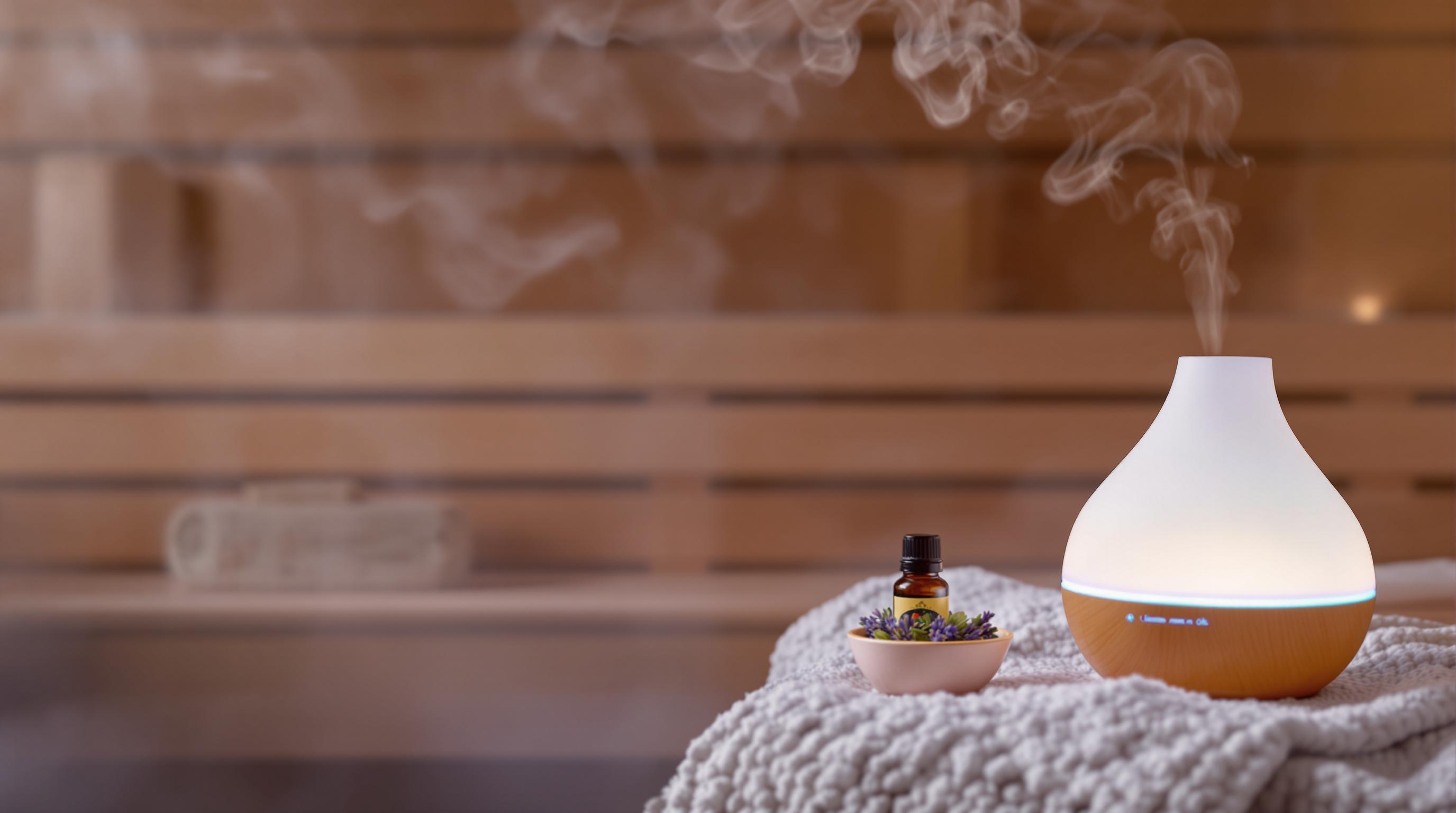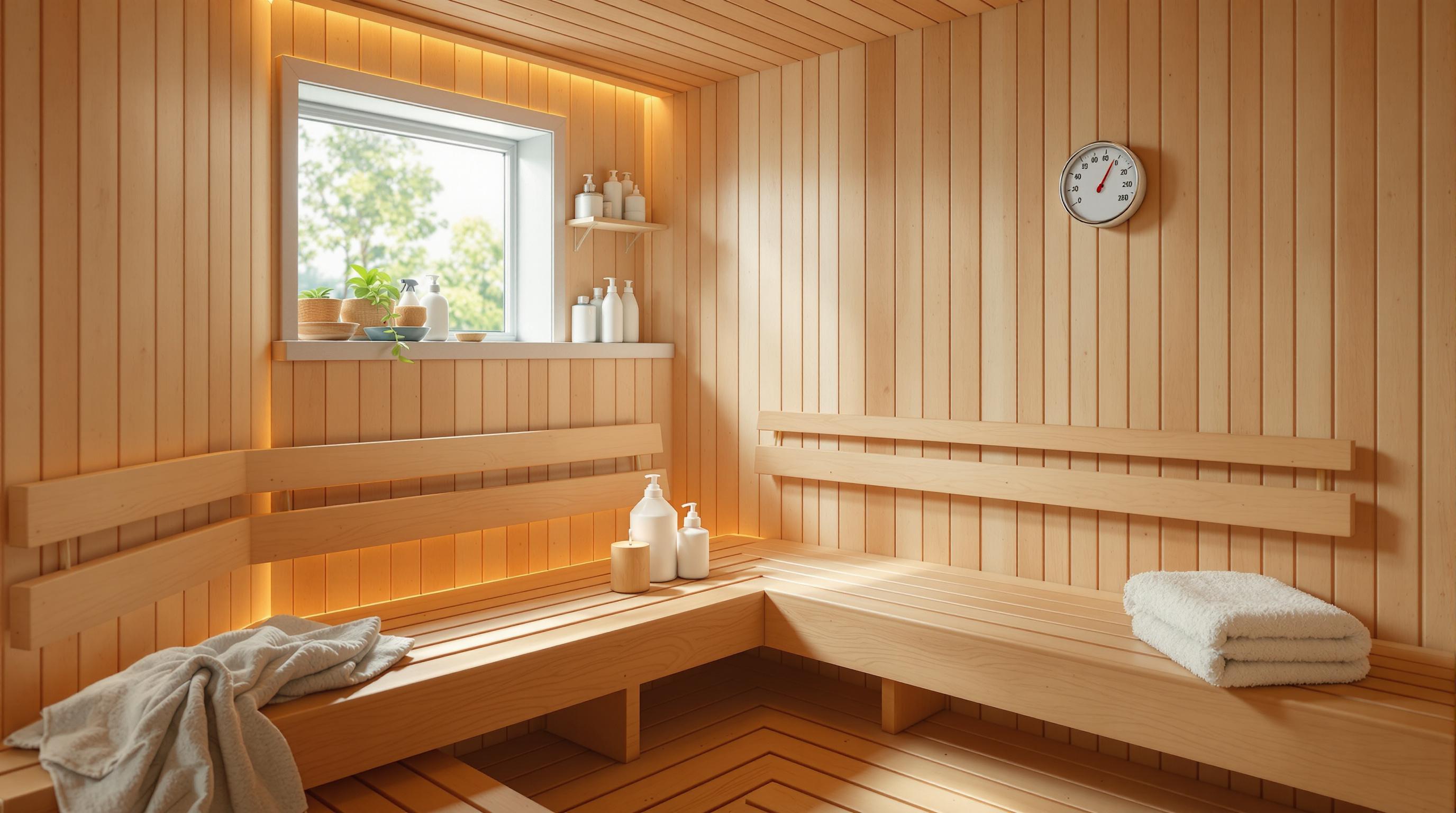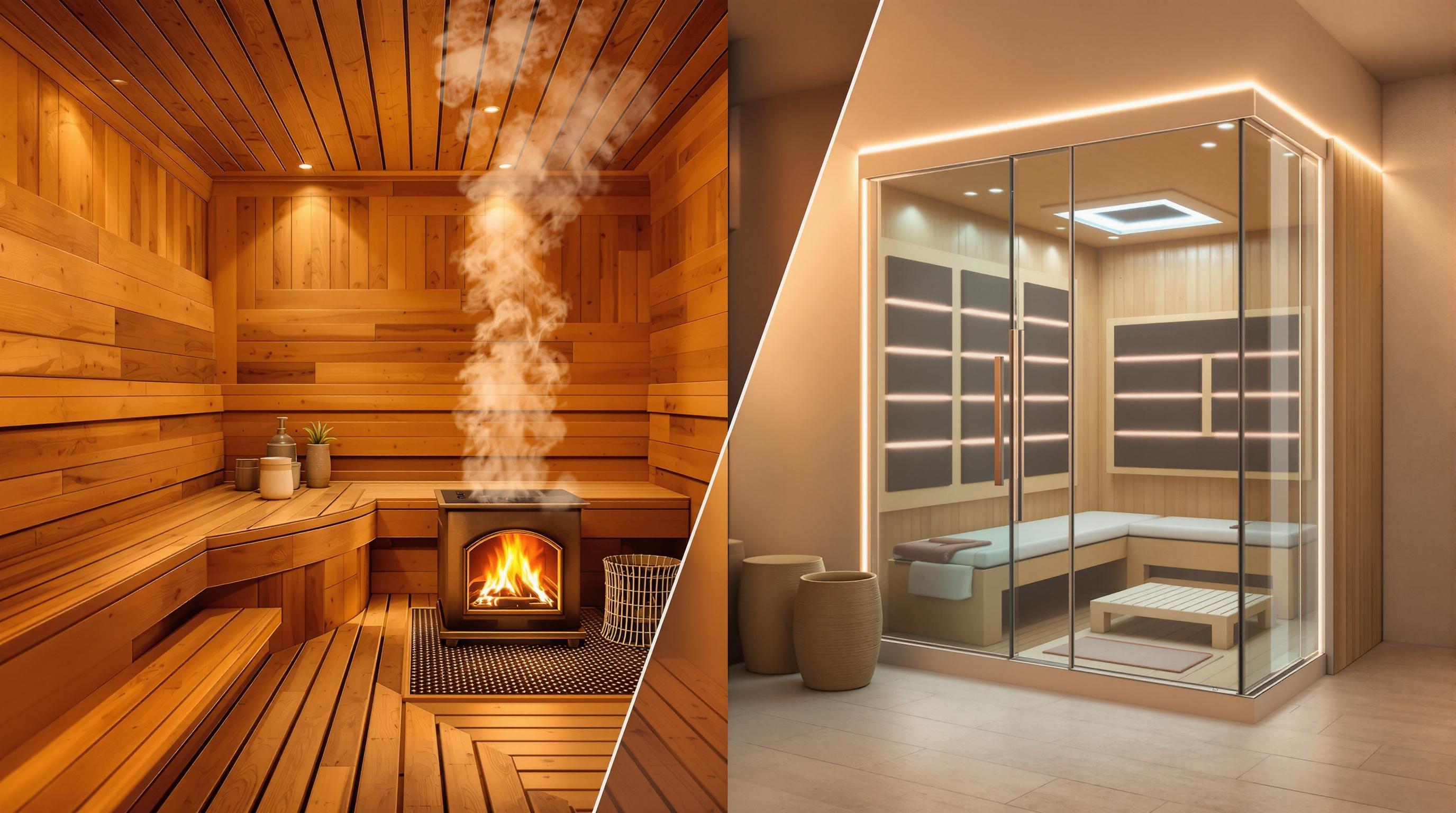Sauna temperatures matter for your health goals. Whether you're aiming for heart health, pain relief, or relaxation, choosing the right sauna type and temperature is key. Here's a quick guide to help you decide:
- 110°F-120°F: Best for beginners, gentle detox, and respiratory support (Steam saunas).
- 120°F-140°F: Ideal for pain relief, muscle recovery, and circulation (Infrared saunas).
- 150°F-195°F: Great for cardiovascular benefits and intense sweating (Traditional saunas).
- 160°F-200°F: High heat for deep detox and stress relief (Wood-burning saunas).
- 100°F-150°F: Convenient and moderate heat for regular use (Portable saunas).
Quick Tip: Stick to your comfort level and gradually increase heat as your body adapts. Always stay hydrated and follow safety guidelines.
The Ultimate Guide to Saunas & Heat Exposure
How Sauna Temperatures Impact Health
Sauna temperatures play a key role in shaping your body's physical responses and the health benefits you might experience. Each temperature range triggers specific effects, making it important to align your sauna use with your health goals.
Health Benefits at Different Temperatures
Traditional saunas (150°F-195°F) are known for supporting heart health. They improve blood vessel function, reduce oxidative stress, and help lower blood pressure, which may decrease the risk of stroke. Infrared saunas, operating at 120°F-140°F, are particularly effective for easing muscle soreness and promoting recovery, making them a favorite for athletes and those dealing with chronic pain.
| Temperature Range | Main Benefits | Ideal For |
|---|---|---|
| 110°F-120°F (43°C-49°C) | Gentle detox, Respiratory support | Beginners, Respiratory issues |
| 120°F-140°F (49°C-60°C) | Pain relief, Muscle recovery | Athletes, Chronic pain management |
| 150°F-195°F (65°C-90°C) | Cardiovascular benefits, Intense sweating | Advanced users, Heart health focus |
How Sweating Supports Detox
The intensity of sweating varies with the sauna's temperature. Steam saunas (110°F-120°F) encourage light detox and are easier on the body, while traditional saunas at higher temperatures promote more intense sweating for deeper detoxification.
Staying Safe with Sauna Temperatures
It's important to avoid using saunas at temperatures above 210°F, as this can be harmful. For traditional saunas, follow the "200 rule": the sum of the temperature and humidity should not exceed 200 for safe use.
Tailoring Sauna Use to Your Goals
Your ideal sauna temperature depends on your experience level and health objectives. Lower temperatures are better for beginners or those with specific health conditions, while higher temperatures are more suitable for seasoned users aiming for cardiovascular benefits.
1. Traditional Saunas: 150°F to 195°F (65°C to 90°C)
Traditional saunas operate at the highest temperature range, offering intense heat that can deliver noticeable effects on the body. With temperatures between 150°F to 195°F (65°C to 90°C) and low humidity levels of 10-20%, these saunas create an environment ideal for promoting wellness.
While all saunas can support heart health, the higher temperatures in traditional saunas are especially effective at improving blood vessel function and flexibility. The intense heat penetrates deeper into tissues, making this type of sauna a great choice for seasoned users looking to maximize the benefits.
Suggested Session Guidelines
| Session Type | Temperature | Duration | Best For |
|---|---|---|---|
| Beginner | 150°F-165°F | 5-10 minutes | Building heat tolerance |
| Intermediate | 165°F-180°F | 10-15 minutes | Regular users, heart health focus |
| Advanced | 180°F-195°F | 15-20 minutes | Intense sweating and relaxation |
For home saunas, proper ventilation is crucial to maintain consistent temperatures and efficiency. Strong insulation is also key to handling the high heat and ensuring the sauna performs effectively.
Safety Tips for High Temperatures
- Start with shorter sessions and pay attention to how your body reacts.
- Stay hydrated, and leave the sauna immediately if you feel dizzy or unwell.
- Allow enough time to cool down between sessions.
Traditional saunas are particularly effective for addressing deep muscle and joint discomfort due to their intense heat. They stand out from lower-temperature options by providing more pronounced therapeutic effects.
If you're looking for a milder experience, infrared saunas might be a better fit, as they operate at lower temperatures while still offering targeted benefits.
2. Infrared Saunas: 120°F to 140°F (49°C to 60°C)
Infrared saunas work within a range of 120°F to 140°F (49°C to 60°C), delivering heat therapy that’s effective without the need for extremely high temperatures.
Temperature Benefits and Session Guidelines
| Temperature Range | Session Duration | Benefits | Best For |
|---|---|---|---|
| 120°F - 130°F | 15-20 minutes | Gentle detox, relaxation | Beginners, those sensitive to heat |
| 130°F - 135°F | 20-25 minutes | Improved circulation, muscle relief | Regular users |
| 135°F - 140°F | 25-30 minutes | Deeper heat penetration, intense sweating | Experienced users |
These saunas come with digital controls to maintain steady temperatures, ensuring both safety and comfort. Start with shorter sessions at lower heat levels, gradually increasing as your body becomes accustomed.
How Temperature Affects Health Benefits
Infrared saunas at these moderate heat levels can provide:
- Muscle Relief: The heat reaches deep into tissues, easing soreness.
- Joint Support: Longer, milder sessions can help with joint flexibility.
- Relaxation: The gentle warmth calms the body without feeling overpowering.
- Better Circulation: Moderate heat encourages improved blood flow.
Infrared saunas heat up quickly and use less energy, making them a practical option for regular use.
They strike a great balance between comfort and results, perfect for anyone looking for a manageable yet effective heat therapy experience.
3. Steam Saunas: 110°F to 120°F (43°C to 49°C)
Steam saunas operate at a lower temperature range than traditional or infrared saunas, typically between 110°F and 120°F (43°C to 49°C). What sets them apart is the high humidity, which creates an intense sweating experience even at these milder temperatures.
Temperature and Humidity Effects
Steam saunas combine moderate heat with 100% humidity to create a therapeutic environment. This combination allows them to achieve noticeable effects without the need for high heat.
| Temperature Range | Humidity Level | Primary Effects |
|---|---|---|
| 110°F - 115°F | 100% | Supports respiratory health, mild detoxification |
| 115°F - 120°F | 100% | Improves circulation, relaxes muscles |
Health Benefits
The mix of moderate heat and high humidity offers several advantages. Steam saunas are especially effective for respiratory health, soothing airways and easing congestion. The moist heat also hydrates skin and promotes muscle relaxation, making these saunas an excellent choice for beginners or those sensitive to higher temperatures.
To get the most out of a steam sauna, it’s important to control both temperature and humidity levels. Start with shorter sessions to gauge your comfort and gradually increase the time as your body adjusts to the humid environment.
If you’re looking for a sauna with adjustable heat options, wood-burning saunas might be a better fit.
sbb-itb-3953eb0
4. Wood-Burning Saunas: 160°F to 200°F (71°C to 93°C)
Wood-burning saunas offer an authentic Finnish sauna experience, operating at temperatures between 160°F and 200°F (71°C to 93°C). These saunas use natural heating methods, creating a mix of dry heat and bursts of humidity when water is poured over the heated stones.
Why This Temperature Range Works
The heat levels in wood-burning saunas are ideal for encouraging sweating and promoting relaxation. The combination of high heat and controlled humidity supports deep tissue comfort and overall wellness.
| Temperature Range | Benefits |
|---|---|
| 160°F - 180°F | Boosts circulation, relieves stress |
| 180°F - 190°F | Supports heart health, aids muscle recovery |
| 190°F - 200°F | Encourages intense sweating, aids in detoxification |
Tips for Safe Use
Start with lower temperatures and shorter sessions, especially if you're new to saunas. Gradually increase the heat and duration as your body gets used to it. Staying hydrated and ensuring proper airflow is key to avoiding overheating. Since these saunas run hotter than electric ones, regular maintenance and careful monitoring are essential.
Wood-burning saunas are a great fit for outdoor spaces, where ventilation is easier to manage. While they require more effort to operate compared to electric models, they deliver a more traditional and immersive sauna experience.
"To get the most out of your sauna sessions, aim for 2-3 times a week, begin with shorter durations, stay hydrated, and always follow safety guidelines."
If you're looking for a simpler option, portable saunas offer a lower-temperature alternative while still providing many of the same wellness perks.
5. Portable Saunas: 100°F to 150°F (38°C to 65°C)
Portable saunas operate within a moderate temperature range, making them a convenient and comfortable option for users of all experience levels. With temperatures between 100°F and 150°F (38°C to 65°C), they offer a range of health benefits while being easy to use at home.
Benefits by Temperature Range
| Temperature Range | Benefits | Ideal For |
|---|---|---|
| 100°F - 120°F | Eases stress, promotes relaxation | Beginners, those with sensitivity to heat |
| 120°F - 135°F | Boosts circulation, reduces pain | Regular users, individuals with arthritis |
| 135°F - 150°F | Supports detoxification, aids muscle recovery | Experienced users, athletes |
These saunas are designed to deliver consistent results in a user-friendly format. The moderate heat can help reduce inflammation and is particularly helpful for managing conditions like arthritis or fibromyalgia.
Safety and Usage Tips
Though they operate at lower temperatures compared to traditional saunas, portable saunas still effectively improve circulation, relieve pain, and support detoxification. Their compact size and controlled heat make them perfect for regular use at home.
To ensure safe and effective sessions:
- Keep the area well-ventilated.
- Stay hydrated throughout your session.
- Use built-in timers to avoid overuse.
- Start with shorter sessions at lower temperatures, gradually increasing as you get comfortable.
Curious about finding the right portable sauna? Check out Find the Home Sauna of Your Dreams for a variety of options tailored to your needs.
Portable saunas are an excellent way to enjoy the benefits of sauna therapy regularly and comfortably in your own home.
How to Choose the Right Sauna for Your Needs
Picking the perfect sauna means thinking about your health goals, available space, and how much heat you're comfortable with. Each sauna type has its own perks, so it’s all about finding what works best for you.
Health Goals
Different saunas are better suited for specific wellness objectives. For example, traditional saunas are linked to improved heart health, while infrared saunas are known for helping with pain relief and detoxification. Consider what benefits matter most to you.
Space Requirements
The size of your space plays a big role in your decision. Traditional and wood-burning saunas need at least 50 square feet and proper ventilation. Infrared saunas are smaller, requiring just 25 square feet. Portable saunas are even more space-friendly since they can be packed away when not in use.
Comfort and Heat Tolerance
Your heat tolerance and experience level are key factors. If you're new to saunas, start with lower-temperature options. Here's a quick breakdown:
- Beginners: Infrared or portable saunas are a good starting point.
- Intermediate Users: Steam saunas or traditional saunas with lower heat settings work well.
- Experienced Users: Traditional or wood-burning saunas at higher heat levels are ideal.
Making the Final Choice
When deciding, think about your health priorities, the space you have, your heat preferences, and your budget. For more guidance, check out Find the Home Sauna of Your Dreams. They offer detailed comparisons, product descriptions, and filters to help you explore saunas by type, size, and features, making it easier to find the right fit for your needs.
Conclusion
Saunas offer a range of health perks when used within the right temperature settings. From the milder 100°F of portable saunas to the intense 200°F of wood-burning ones, each type provides a unique experience. This variety makes it easier to align your sauna sessions with goals like improving heart health, easing pain, or simply relaxing.
Keeping the temperature in check is crucial for both safety and effectiveness. While regular use delivers the best outcomes, even 2-3 sessions a week can make a difference. The trick is to find what feels right for you while sticking to safety guidelines.
Here are a few tips for getting the most out of your sauna sessions:
- Choose the sauna type that fits your specific wellness goals.
- Build your heat tolerance step by step.
- Stay hydrated and follow basic safety measures.
- Check with a healthcare provider if you have specific concerns.
Whether your focus is on heart health, stress relief, or pain management, the temperature you choose plays a big role in your results. By tailoring your sauna routine to your needs, you can enjoy its full benefits and support a healthier, more balanced lifestyle.
FAQs
Below, we address common questions to help you make informed choices about sauna use.
What is the 200 rule for saunas?
The 200 rule suggests that the sauna's temperature (in °F) plus its humidity (in %) should not exceed 200. For instance, if the sauna is set to 190°F, the humidity should stay below 10%. This balance ensures a safe and comfortable environment while still providing wellness benefits.
Is 200 degrees too hot for a sauna?
While 200°F is safe for traditional saunas, it’s at the higher end of the temperature range. Most people find 150-175°F more comfortable and effective. If you're new to sauna use, it's wise to begin with lower temperatures and gradually increase as your body adapts to the heat.
Is 120 degrees good for a sauna?
120°F is ideal for steam and infrared saunas, offering benefits like improved breathing and muscle relaxation without overwhelming heat. Steam saunas pair this moderate temperature with higher humidity for therapeutic effects.
- Traditional saunas: Best at 150-195°F
- Infrared saunas: Optimal at 120-140°F
- Steam saunas: Work well at 110-120°F
Tip: Always start with a lower temperature and adjust based on your comfort and health needs. If you're considering a home sauna, check out TopHomeSauna.com for options tailored to your preferences and wellness goals.
Following these temperature guidelines can help you enjoy a safe and effective sauna session tailored to your needs.


